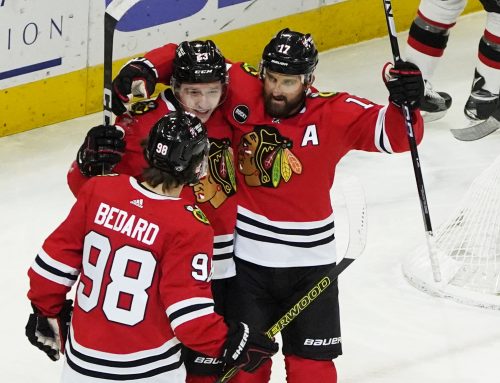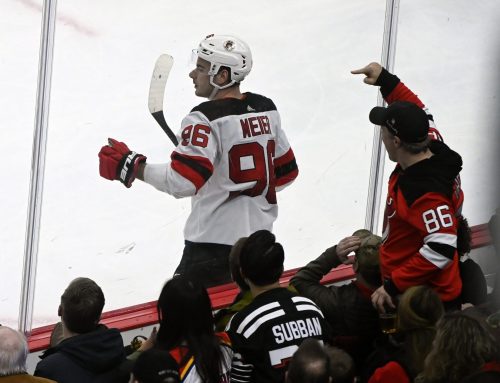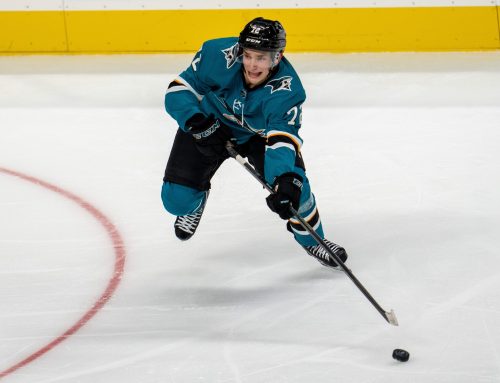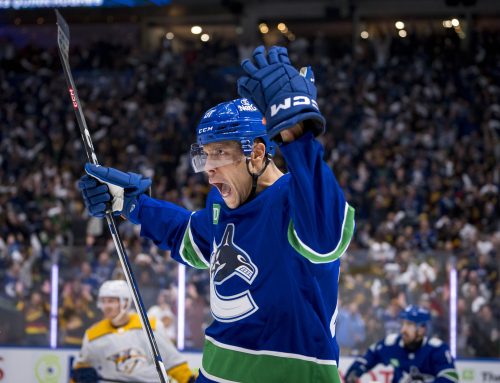Ramblings: the Vegas power play; the Montreal blue line; the superstar heading overseas; Staal/MoJo swap – September 17
Michael Clifford
2020-09-17
We've seen lots of young players head overseas as their teams try to continue their development, and that makes all the sense in the world with so much time between last season and next season. I also saw Joe Thornton went back to Davos where he played during the lockout but he hasn't suited up in a game yet.
And then there's this:
Sounds like #LetsGoOilers Leon Draisaitl will be returning home to play in Germany for the time being. Kolner Haie, under coach Uwe Krupp, appears to be the landing spot.
— Alex Thomas (@Alex_Thomas14) September 16, 2020
That's a significant player heading overseas to get into some games.
I've talked about the NHL's 2020-21 timeline before, and this is another point in the column for the next regular season not starting anytime soon (and by that, I mean anytime in 2020). Players that get eliminated in a normal regular season sometimes go to the World Championships, but those finish by the end of May. It still gives players three months, effectively, to recover for the next season. It's not to say there'll be three months between whenever Drai leaves Germany and the next NHL season, but I don't imagine Draisaitl leaves to go play in Germany if he and the Oilers are expecting the league to start back up in 10 weeks, as was their initial plan.
[edit: he’s not able to play games officially as of yet. For now, like Thornton, he’ll be going for training next month.]*
In a straight-up trade, the Wild and Sabres swapped Marcus Johansson and Eric Staal. The former had 30 points in 60 games last year while Staal had 19 goals and 47 points in 66 games.
I’m going to go more in-depth in my next Ramblings but on the surface, this makes little sense to me. Of all areas the Wild are weakest, centre is glaring, and they just traded their top-line centre for a third-line winger. This puts a lot of pressure on guys like Eriksson-Ek and Bjugstad to not only step up but thrive in roles they’re not accustomed nor have proven themselves capable. This is a team that has Fiala, Parise, Zuccarello, and now Kaprizov as hopefully top-6 wingers. There are useful bottom-6 wingers like Donato, Hartman, Greenway, and Foligno that are up to that task as well. They have a blue line that is pretty stocked, too. What they need is help at centre and help in goal. MJ90 can be moved to centre but that was a trainwreck in Buffalo and he’s largely been a winger for eight years. Someone explain this to me like I’m five.
*
François Gagnon of RDS was reporting that a contract for Joel Edmundson from the Habs was imminent, and that it was expected to be in the 3-5 year range around $4M a season. That did come through, as he signed for four years at $3.5M per season with a 10-team no-trade clause. A few notes:
- In the four seasons leading up to Bergevin signing Karl Alzner in 2017, per Evolving Hockey, Alzner was worth one win roughly every 2000 minutes of ice time. That's basically third-pair status and, unsurprisingly, Alzner has spent most of his Montreal tenure in the AHL.
- In the four seasons leading up to Bergevin signing Ben Chiarot in 2019, per Evolving Hockey, Chiarot was worth one win roughly every 4000 minutes of ice time. That's close to non-NHL level. Unsurprisingly, he was a negative-win player in 2019-20, and the pairing of Weber-Chiarot wasn't very good in the postseason, coming in at 48.1 percent expected goal share and 42.4 actual goal share. (With that pair off the ice, the Habs had a 57 percent expected goal share and 55.8 percent actual goal share. Shutdown pairs only work if they're good.)
- Over the last four seasons, per Evolving Hockey, Edmundson has been worth negative 1.7 wins, making him worse than either Alzner or Chiarot at the point where he's signed. Is that good?
They’ll have nearly $12M in cap space tied up between Alzner/Chiarot/Edmundson (before Alzner's eventual demotion and whatever savings that entails). That's three defencemen taking up roughly 15 percent of cap space and there may not be an NHL-calibre blue liner in there. Chiarot may be fine as a 6/7 guy.
Anyway, I'm real interested to see how this works out for the Habs. My guess: poorly. I’ll happily correct myself if he’s a 1-2 win player for his four seasons.
*
While we're sitting here waiting to see who will be heading to the Stanley Cup Final from the East, I wanted to take the time to go over the Vegas/Dallas series a bit more, seeing as I didn't have much opportunity in my Ramblings covering that game. This will cover mostly the Vegas side because, well, they lost.
Of everything that happened in that series, here's what stuck out to me: they were running the power play to get Max Pacioretty a one-timer. To describe how insane that is, Hockey Viz's goals model has Pacioretty shooting somewhere between 6-7 percent for his career from the top of the circles on the power play off slap shots. Vegas was running their power play with the end goal of having a guy take a slapshot that was low-percentage. Other than that, it was going through Shea Theodore, a defenceman. And Nate Schmidt was second on the team in shot attempts/60 on the power play in the Dallas series.
So, the Golden Knights were letting Theodore/Schmidt rip the puck indiscriminately, with Max Pacioretty waiting for a one-timer. They should consider themselves fortunate that they scored three PP goals in five games. In total, Vegas's power play scoring rate this postseason (5.71/60 minutes) was worse than that of the Columbus Blue Jackets (5.9/60 minutes).
I'm not an NHL coach. I'm not even a youth coach. I don't know the best way to run a power play. What I do know is that your power play should never run on either bombing shots from the point or through an historically low-percentage shooter. Those two things seem blatantly obvious to me, so I'm wondering if I'm missing something here. Both William Karlsson and Reilly Smith, to me, are better suited for that role. Again, I'm earnestly asking if I missed something (maybe something DeBoer said in a press conference or an injury to a player or even just the puck movement of the PP itself) because this seems like a glaring, obvious mistake that probably cost them goals all postseason long. If someone has some insight I missed, please let me know in the comments. This is melting my brain.
Sticking with Vegas and the power play, it's notable that they went to a heavily-used top PP unit in the Dallas series. Whereas they would normally have seven or eight forwards basically within 45 seconds of each other in PPTOI per game, that changed in the Dallas series as, for example, Mark Stone played nearly 4:30 per game with Marchessault/Stastny closer to 2:30.
If it's something that persists into next season, it changes the valuation for a lot of their top players. Some guys playing 3:30 or so per game in PPTOI and others closer to two minutes or less is much different than everyone more or less playing 2:45 a night.
Other than that, there's probably not much to break down from a Vegas perspective. They absolutely rolled the playoffs at 5-on-5, posting a 62 percent expected goal share at 5-on-5 to go with a 57.4 percent actual goal share. They ran into Thatcher Demko and Anton Khudobin, two goalies in two different series who combined for a .966 save percentage over nine games. That's less than one goal every 25 shots. Goaltending really is the ultimate equalizer.
One guy I was really impressed with through the postseason was Zach Whitecloud. He came in and really helped lock things down defensively. He was the unfortunate recipient of that puck-over-glass penalty and that sucks. All the same, he was a revelation for them and they have the entire postseason blue line under contract for next year. That's a good start.
*
As years have passed, I've tried staying out of the analytics debate. For one, I'm not very smart. For two, the arguments were redundant. Some people believed in math, some refused. Those lines have been more or less constant for 6-7 years now. But the latest round of arguments has me kind of riled up and, well, these are my Ramblings.
I want to be as basic as I can about this, so please excuse if this is all elementary.
What is the point of running an NHL franchise? To win the Stanley Cup. How do you win the Stanley Cup? Well, first you need to make the playoffs. Not only that, but building a solid core of players that can reach the playoffs year after year which gives you plenty kicks at the can. How do you build a solid core of players? By drafting, signing, and trading for players you (the franchise) evaluate can help your team. In order to evaluate which players can help your team, you need to be able to evaluate players against one another. Who is good, who is bad, and who can help win and how. Comparisons are necessary to see who is better at what, and that's where analytics come in. Who is good at transitioning in the neutral zone? Who is good at finding teammates for scoring chances in the offensive zone? Who shoots from distance that shouldn't and who struggles in different roles? Analytics can answer – or at least partially answer – a lot of these questions.
No one says things like 'heart' and 'grit' don't matter. Of course they do. The question is how do you compare players? Who has more heart: Ryan Pulock or Victor Hedman? Is it Hedman if Tampa wins the series, or is it Pulock if they Isles come back to win it? Who has more grit between Alex Radulov or Mark Stone? Traditional thought would say Radulov because his team won the series. If you were starting a franchise tomorrow, who would you want as your RW1? Do people see how absurd this line of thinking is now?
It's not to say that I think 'heart' and 'grit' are stupid observations. Those kinds of intangibles exist and they're important for success in many aspects of life both inside and outside of sport. It's that we can't say who has more of it than others at the NHL level. Ask yourself who has more heart between Mat Barzal and Brayden Point and earnestly answer it.
That's what bugs me about the latest arguments. You cannot earnestly answer who has more heart between the pairs of players mentioned above and for that reason, just stammering "they have HEART" is useless; of course they do. I'd wager most elite-level athletes – the point-zero-zero-one percent of athletes – have a lot of intangibles we'd categorize as heart or grit.
This isn't uncommon for human beings. We ascribe effects we can't quantify to explain the unexplainable all the time. I just wish people would respect math instead of fear it.





 T.B
T.B FLA
FLA NYI
NYI CAR
CAR TOR
TOR VGK
VGK EDM
EDM VAN
VAN MIN
MIN STL
STL CHI
CHI
